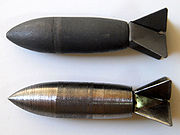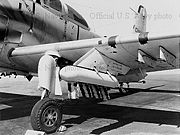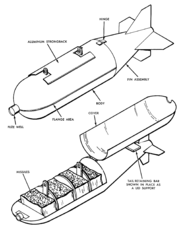
Lazy Dog (bomb)
Encyclopedia



The weapon
Weapon
A weapon, arm, or armament is a tool or instrument used with the aim of causing damage or harm to living beings or artificial structures or systems...
s were designed to be dispersed over the battle
Battle
Generally, a battle is a conceptual component in the hierarchy of combat in warfare between two or more armed forces, or combatants. In a battle, each combatant will seek to defeat the others, with defeat determined by the conditions of a military campaign...
field with Mark 44 cluster adapters. Lazy dog bombs were technically not bombs because they used no explosive, but were in many ways equally destructive. Mark 44 cluster adapters were one of many possible means to deliver "Lazy Dog" projectiles.
Development
Lazy dog bombs were descended from projectiles of almost identical design and appearance that were originally developed early in World War IIWorld War II
World War II, or the Second World War , was a global conflict lasting from 1939 to 1945, involving most of the world's nations—including all of the great powers—eventually forming two opposing military alliances: the Allies and the Axis...
as early as 1941. The Korean War
Korean War
The Korean War was a conventional war between South Korea, supported by the United Nations, and North Korea, supported by the People's Republic of China , with military material aid from the Soviet Union...
-era and Vietnam War
Vietnam War
The Vietnam War was a Cold War-era military conflict that occurred in Vietnam, Laos, and Cambodia from 1 November 1955 to the fall of Saigon on 30 April 1975. This war followed the First Indochina War and was fought between North Vietnam, supported by its communist allies, and the government of...
-era "Lazy Dog" was further developed, tested and deployed into the 1950s and 1960s.
Originally an Armament Laboratory program codenamed LAZY DOG, the weapon's development involved Delco Products Corporation, F&F Mold and Die Works, Inc., Haines Designed Products, and Master Vibrator Company of Dayton. The project objective was to design and test free-fall missiles and their dispensing units
Dispenser
-Containers and machines:Various machines that dispense things:* Automatic toothpaste dispenser* Cash dispenser * Hearing aid dispenser* Label dispenser* Klik Rockets Dispenser, a candy dispenser* Paper towel dispenser...
for use in bombers and fighters. LAZY DOG anti-personnel missiles were designed to spray enemy troops with small projectiles with three times the force of standard air-burst bombs. The Armament Laboratory worked with the Flight Test Laboratory to conduct wind tunnel tests of a number of bomb shapes which design studies indicated to be the most efficient for stowage and release from high performance aircraft.
Experimental LAZY DOG projectiles of various shapes and sizes were tested at Air Proving Ground, Eglin AFB, Florida, in late 1951 and early 1952. An F-84 flying at 400 knots and 75 feet above the ground served as the test bed while a jeep
Jeep
Jeep is an automobile marque of Chrysler . The first Willys Jeeps were produced in 1941 with the first civilian models in 1945, making it the oldest off-road vehicle and sport utility vehicle brand. It inspired a number of other light utility vehicles, such as the Land Rover which is the second...
and a B-24 were the targets. The result was eight hits per square yard. Tests revealed Shapes 2 and 5 to be the most effective. Shape 5, an improved basic LAZY DOG slug, had the force of a .50 caliber bullet and could penetrate 24 inches of packed sand. Shape 2 could penetrate 12 inches of sand — twice as much as a .45 caliber slug
Slug (projectile)
A slug is a term used for a solid ballistic projectile. It is "solid" in the sense of being composed of one piece; the shape can vary widely, including partially hollowed shapes...
fired point blank.
Deployment
The Shape 2 projectile was sent to the Far East Air Force (FEAF) for combat use by mid-1952. FEAF immediately ordered 16,000 Lazy Dog weapon systems. An Air Force Lieutenant ColonelLieutenant colonel
Lieutenant colonel is a rank of commissioned officer in the armies and most marine forces and some air forces of the world, typically ranking above a major and below a colonel. The rank of lieutenant colonel is often shortened to simply "colonel" in conversation and in unofficial correspondence...
named Haile attached to the Armament Laboratory spent 90 days in Japan
Japan
Japan is an island nation in East Asia. Located in the Pacific Ocean, it lies to the east of the Sea of Japan, China, North Korea, South Korea and Russia, stretching from the Sea of Okhotsk in the north to the East China Sea and Taiwan in the south...
to set up local manufacture of the Lazy Dog weapons and train crew members in their use. Project LAZY DOG continued throughout 1952 to determine the optimum characteristics for stable dispersion containers and the feasibility of substituting a LAZY DOG warhead for the explosive nose of the Matador. The LAZY DOG program was still ongoing in the late 1950s.
The rationale for using lazy dogs in the Vietnam War was because they were highly effective against enemy troops hidden beneath the jungle canopy. The munitions were also cheap and easy to scatter over large areas. Like many other weapons, however, their effects were often gruesome and indiscriminate. "Lazy Dog" projectiles were also referred to by other names such as "lawn darts" or "buzz bombs" because of their similar shape to both those objects.
Lazy Dog projectiles were dropped in very large numbers, and usable with almost any kind of flying vehicle. They could be hurled from buckets, dropped by hand, thrown in their small shipping bags made of paper, or placed in a Mark 44 cluster adapter—a simple hinged casing with bins built in to hold the projectiles, opened by a mechanical time delay fuse
Fuse (explosives)
In an explosive, pyrotechnic device or military munition, a fuse is the part of the device that initiates function. In common usage, the word fuse is used indiscriminately...
as shown. The adapters themselves were 69.9 inches long and 14.18 inches in diameter. They would be shipped empty, then filled by hand. Depending on how many projectiles could be packed in, loaded weight varied between 560 and 625 pounds, with the theoretical maximum number of projectiles listed as an astonishing 17,500.
Regardless of how they were released into the air, each "Lazy Dog" projectile would develop an incredible amount of kinetic energy as it fell, penetrating nearly any material upon hitting the ground. Some reports say that their speeds often exceeded 500 mph before impact.
One period military manual with information on this weapon system, dated 04/27/69, had the awkward name "Resume of Technical Data on Conventional Munitions used in Special Air Warfare Activities."
A variant version of the "Lazy Dog" projectile was developed for the recoilless rifle
Recoilless rifle
A recoilless rifle or recoilless gun is a lightweight weapon that fires a heavier projectile than would be practical to fire from a recoiling weapon of comparable size. Technically, only devices that use a rifled barrel are recoilless rifles. Smoothbore variants are recoilless guns...
. However, development was suspended because another kind of flechette solution was used for the recoilless rifle instead.
Demise
Because lazy dog bombs were regarded as an experimental weapon throughout the period of their use, and were never deployed widely enoughto be commonly sold as military surplusMilitary surplus
Military surplus are goods, usually matériel, that are sold or otherwise disposed of when no longer needed by the military. Entrepreneurs often buy these goods and resell them at surplus stores. Military surplus rarely includes weapons or munitions, though they are occasionally found in such stores...
, therefore all versions of them are now highly sought after by military collectors. In the 1970s and 1980s, they could routinely be found for sale at gun shows, but now they are rarely if ever for sale because the supply has been almost completely exhausted. Especially collectible are the earlier forged steel Parkerized finish designs. Later lathe-turned steel examples, including unissued specimens and rusted examples picked up from battlefields, can usually be found on popular auction sites and vertical-market gun auction sites for prices ranging from $15.00 USD to $75 for a set of 10 unissued units. The earlier forged models rarely come up on the auction sites, and generally fetch $80.00 for a single unissued unit.
External links
- High-Resolution Lazy Dog Photos at Ike's Surplus
- Lazy Dog at Texas Trading Post
- Lazy Dog at Vietnam Gear

